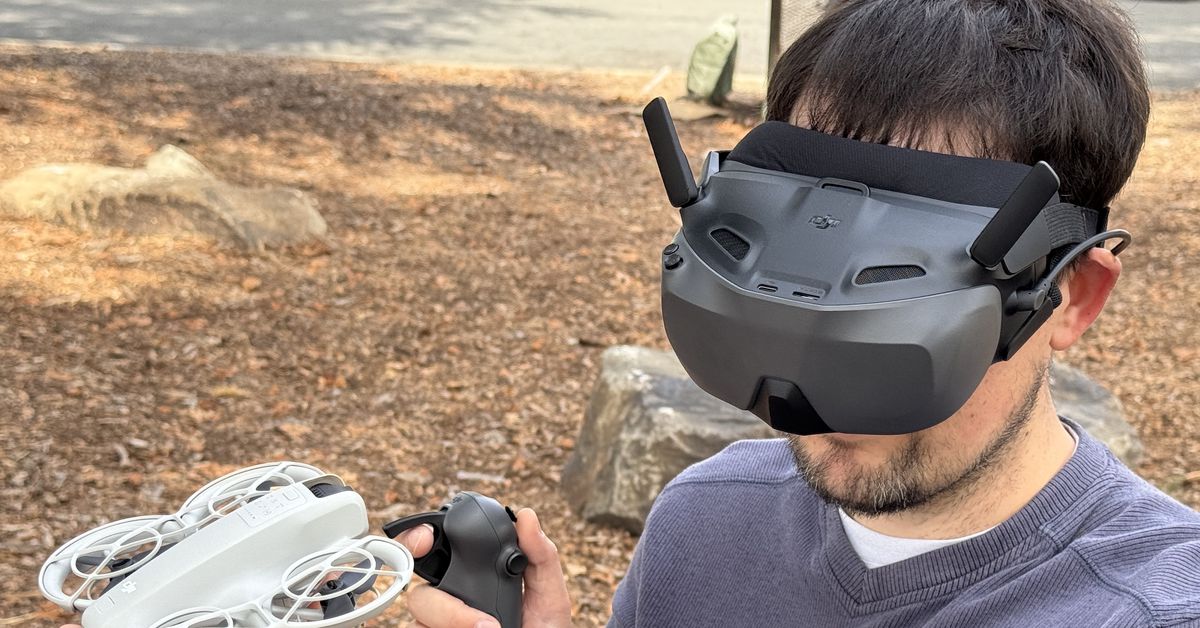I’m hoping DJI’s affordable new FPV goggles will be the missing puzzle piece — a way to cheaply buy the “It feels like I’m flying!” experience I had with the DJI Avata for maybe $400 or $500 tops, rather than the current $800 to $1,000 you might have to pay.
See, the company announced its budget $199 Neo drone in September that works with goggles, and today it’s announcing the $229 DJI Goggles N3. Add a $99 RC Motion 3 controller and you get airplane-like flight, with first-person video that puts you in the virtual cockpit.
But I can’t quite confirm that it’s worth your money yet — because DJI says my unit likely shipped with a defect, and I’ll need a little more testing time. More on that below.
At $229, the Goggles N3 are definitely less expensive than previous pairs, saving you $120 over the company’s $349 Goggles Integra, its previous budget set, and they’re less than half the price of the premium $499 DJI Goggles 3. Yet they’ve got the same one-tap defogging (using an internal fan) and DJI O4 video transmission as the Goggles 3. I flew the Neo just as far with the DJI’s cheapest and most expensive goggles before the signal cut out and the drone found its way home. You still get headtracking so you can look up and down while you’re flying forward, too.
On paper, the N3 even seem better than the more premium models in a couple ways: a wider 54-degree field of view (compare to 44 degrees), an eyebox so big you can put your prescription glasses inside, with no need to twist knobs to make the lenses match your vision, the company claims.
But instead of the crisp, colorful, perfect micro-OLED screens included in all of DJI’s other modern FPV goggles, the N3 has a single, comparatively washed-out LCD screen inside. To aim that panel at your face, there’s a big diagonal optic inside (not unlike a periscope) to bounce the light at a right angle.
In the case of my review unit, the center of my screen seems to be aimed at the center of my nosepiece. With no way to adjust the lenses, I’m stuck with an out-of-focus image all the time. Not being able to properly see anything has got to be a fluke, right? DJI spokesperson Daisy Kong tells me over the phone that I might have a defective unit.
If it is just a fluke, I’d be fine with most of the other corners DJI has cut. I could live with a slightly washed out image. I don’t miss the loss of the Goggles 3’s barely useful passthrough vision or silicone padding — fabric’s good enough for me. I don’t terribly mind that the Goggles N3 has a visible cable sticking out the side instead of weaving it into the headband like previous models.
While it’s heavier, it’s only 2.3 ounces (65g) heavier than the Goggles 3 according to my kitchen scale, and it’s still reasonably balanced out by the integrated battery at the back of the headset. Frankly, even the Goggles N3 has more wireless range and more fancy features than I typically need. But the core of the experience needs to be a crisp, clear look through the eye of the drone. I’ll let you know if that materializes in the next couple of weeks.
I should also note that the DJI Neo isn’t anywhere near as good as the Avata or Avata 2 at being an FPV drone, simply because of its weight and power ratios — it’s not as nimble as those more dedicated models, and the wind can more easily push it around.
Like them or not, DJI doesn’t have a lot of other affordable FPV options on the table. The company recently discontinued its $829 Avata Explorer Combo (though you can find some refurbished deals), and Kong says there are “no current plans” to let you use the $350 Goggles Integra with the DJI Neo, even though DJI now lets you use the Avata 2 and DJI Mini 4 Pro with the Integra. So if you don’t like the Goggles N3, the $500 Goggles 3 is the only other set that currently works with the Neo.
In the US, where DJI is facing some import difficulties, it’ll only sell the the Goggles N3 on its own, just as it only sells the DJI Neo on its own. In the UK and Europe, it’s a bundle to start: the new “DJI Neo Motion Fly More Combo” with drone, goggles, controller, three batteries, and a charging hub is available today for £449 or €529, with the standalone $229/£229/€269 Goggles N3 estimated to arrive in late November.

